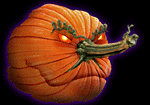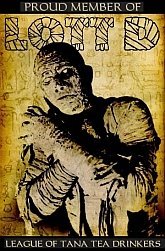Almost side by side came the violence of the crime comic and the sugariness of teenage romance, then at the very end of the decade a handful of horror comics clawed their way onto the distributors' schedules. Each spawned an abomination, the like of which had never before been seen in a comic book. Within a matter of years outrage followed on outrage as the contents of these so-called comics emerged to become the most notorious in the industry's short-lived history. (Peter Normanton in The Mammoth Book of Best Horror Comics)
Zombos Says: Excellent
I am tired. The air is turning colder. My most singular experience is almost at an end. This is my last hope of conveying the enormity of the maddening horror, the numbing terror that has seized my heart, my mind. Sweat from fear makes it difficult to write, but I must...I must relate this most sordid of affairs, this break in the fabric of normalcy, of decency. I neither solicit your belief nor disbelief--you must listen, I beg you to listen, to heed what I say. My time grows ever shorter. He is coming closer...so damned close now. I must leave some record, some thoughts--if only I could focus better, calm my racing mind---some words to warn you before it's too late, before he finds me...
"There you are!" said Zombos. "Time's up. You've had it long enough." He held out his hand.
"But I'm not done yet," I pleaded. "Just another hour. One more hour, surely," I begged.
"Nope. It's my turn to read The Mammoth Book of Best Horror Comics. Next time, Zoc, listen to me when I tell you to order two copies."
The grandfather clock in the hallway scolded me, or was it just striking the midnight hour? Was that the flittering of bat's wings? Perhaps Zombos was right; maybe I had spent much too much time with these ghoulish, morbid horrors from the 1950s, 60s, and 70s? I reluctantly handed the book to Zombos. He cackled with glee and scurried back into the darkness to gnaw away on his prize--or so I imagined.
Edited by Peter Normanton (publisher of the essential From the Tomb magazine), the fifty crème de la crème horror comics and graphic stories presented within its moldering pages are enough--happily--to wake the dead and incite parents everywhere. Over four hundred pages of memorable atrocities, clawing up from the grave into your nightmares; it's a dream come true for horrorheads everywhere!
 Describing how he became hooked on horror comics after seeing Sebastia Boada's long-haired naked babe lounging with hairy ape-thing cover illustration for Skywald's Nightmare No.17, in 1974, Normanton quickly jumps into the thick of it starting with gruesome gems from the 1940s and 50s in his section entitled The Dark Age of Comics. Although he writes "it wasn't the bare flesh that got me excited , it was the beast looming in the background and the threat this moody scene invoked," regarding that suggestive cover, it's obvious his wife was looking over his shoulder when he wrote his remembrance; so I'll cut him some geek-slack. It took me a few minutes to even notice the chained, uni-horned, beast in the moody background anyway.
Describing how he became hooked on horror comics after seeing Sebastia Boada's long-haired naked babe lounging with hairy ape-thing cover illustration for Skywald's Nightmare No.17, in 1974, Normanton quickly jumps into the thick of it starting with gruesome gems from the 1940s and 50s in his section entitled The Dark Age of Comics. Although he writes "it wasn't the bare flesh that got me excited , it was the beast looming in the background and the threat this moody scene invoked," regarding that suggestive cover, it's obvious his wife was looking over his shoulder when he wrote his remembrance; so I'll cut him some geek-slack. It took me a few minutes to even notice the chained, uni-horned, beast in the moody background anyway.
Normanton gives a capsule history of this outlandish dark age, outlining publishers, titles, and the terminal impact notorious psychologist Dr. Frederick Wertham--"whose work maligning horror and crime comics appeared in an assortment of women's journals during the 1940s and on into the early 1950s"--had on the demise of the lurid, but lucrative, bloody mayhem originally printed in four colors every month.
Each delectable story, reprinted here in ominous black and white, begins with the issue's cover and background notes on the artist and writer (often the same person); a great way to give credit where it's due (or the blame for that matter). For the horror comic reader, it's information frightfully useful when compiling a must-read list of influential talents in the genre. Here you will run screaming from Don Heck's Hitler's Head in Weird Terror No.1, and sweat profusely along with Rudy Palais' travelers in dire trouble in He, grippingly told in Black Cat Mystery No.38. Recurring macabre themes of the newly animated dead, the reluctantly dead, and the soon-to-be-dead, shadow dance their way among the graveyards, castles, and dark forests, partying it up with ghosts, ghouls, vampires, werewolves, and the depraved indifference exhibited by the usual neo-Nazis, scheming relatives, and whip-cracking, radiantly beautiful and well-endowed women with ill intent.
At their zenith, 1950's horror comics contained torture, masochism, depravity, numerous dismembered and rotting parts, numerous rotting and decapitated heads, and numerous, radiantly beautiful and well-endowed women in various stages of distress (and undress). Monsters, zombies, witches, ghoulies and ghosties, leered, jeered and scared their way across the pulpy pages, leaving shock and delightfully gruesome death in their wake. Maybe Wertham wasn't so off the mark after all?
--Hello, stop staring at that moody, chained hairy beast already and pay attention!--
 In the next section, The Terror Returns, horror comics published under the dubious auspices of the Comics Code in the 1960s and 1970s are represented quite well, beginning with my all-time favorite, The Monster of Dread End, from Dell's Ghost Stories No.1. Gone are the more graphically executed uses for a cat-o-nine tails and the colorful eye-dangling from socket, axe-split decapitated head--held by the hair--covers and plotlines. The hideous artwork of the 50s gave way to the toned-down, more suggestive and parent-friendly stylizations of Dell, Gold Key, Charlton, Marvel and DC. That is, until publisher James Warren realized the Comics Code didn't apply to magazines. He used the black and white magazine format for more freedom in expressing horrific storylines graphically, and with the birth of his Creepy, Eerie, and Vampirella magazines, brought sophisticated adult terror to eager young, and old, readers, alarming everyone else in the process. Other publishers sought to emulate the format after the success of Warren Publishing's offerings, and soon the luncheonette and newsstand magazine racks were filled to the brim with imitators and innovators. As the competition heated up, so did the mature content, which reached its creative pinnacle in Skywald's Horror-Mood Psycho, Nightmare, and Scream magazines.
In the next section, The Terror Returns, horror comics published under the dubious auspices of the Comics Code in the 1960s and 1970s are represented quite well, beginning with my all-time favorite, The Monster of Dread End, from Dell's Ghost Stories No.1. Gone are the more graphically executed uses for a cat-o-nine tails and the colorful eye-dangling from socket, axe-split decapitated head--held by the hair--covers and plotlines. The hideous artwork of the 50s gave way to the toned-down, more suggestive and parent-friendly stylizations of Dell, Gold Key, Charlton, Marvel and DC. That is, until publisher James Warren realized the Comics Code didn't apply to magazines. He used the black and white magazine format for more freedom in expressing horrific storylines graphically, and with the birth of his Creepy, Eerie, and Vampirella magazines, brought sophisticated adult terror to eager young, and old, readers, alarming everyone else in the process. Other publishers sought to emulate the format after the success of Warren Publishing's offerings, and soon the luncheonette and newsstand magazine racks were filled to the brim with imitators and innovators. As the competition heated up, so did the mature content, which reached its creative pinnacle in Skywald's Horror-Mood Psycho, Nightmare, and Scream magazines.
 Normanton mixes in engrossing stories from Psycho and Nightmare, as well as Charlton's Ghostly Haunts and Ghostly Tales, and adds a story from Eerie Publications' Weird . Eerie Publications? They're the ones your mom warned you about. With the nastiest covers and grindhouse-level storylines imaginable, their titles stand as the epitome of entertainingly tasteless horror-fare. Normanton tosses in one of their tamer offerings.
Normanton mixes in engrossing stories from Psycho and Nightmare, as well as Charlton's Ghostly Haunts and Ghostly Tales, and adds a story from Eerie Publications' Weird . Eerie Publications? They're the ones your mom warned you about. With the nastiest covers and grindhouse-level storylines imaginable, their titles stand as the epitome of entertainingly tasteless horror-fare. Normanton tosses in one of their tamer offerings.
When reading this section of Mammoth's Best Horror Comics, the differences between the Comics Code-restrained stories, and the unfettered black and white forays into terror, offer a fascinating comparison between the creative talents involved working under both circumstances. In the comic book format, more suggestive and imaginative excursions into the supernatural are the norm, while the black and white horrors in the larger print format relied on more visually-appalling panels, and a simpler, more direct approach in story-telling.
After the explosion of horror titles ended in the 1970s, Normanton goes on to the lean years of the 1980s and 90s, and more recent horror titles in the book's last two sections entitled, The Faithful Few, and A New Millennium for the Macabre -- the 21st Century, respectively. Having rekindled my love for illustrated horror within the last two years, these sections provide a wealth of reading-list material for me to explore. From Peter Von Sholly's photo-montage remake of John Stanley's The Monster of Dread End, to Cal McDonald: A Letter From B.S., these stories highlight the continuing sophistication in both artwork and writing that keep the illustrated-horror genre evolving and vibrant.
The Mammoth Book of Best Horror Comics is a treasure-trove that will provide hours of pleasure to the horror lover, and mortify just about everyone else. So better read it late at night, when the rats in the walls have quieted down, and "For the love of God, Montressor!" no longer echoes loudly through the dark, fungi-soaked catacombs, but whispers oh-so-softly at the edges of your mind. Just make sure to buy two copies, so you'll be left in peace when the walking dead come calling to read it, too.




